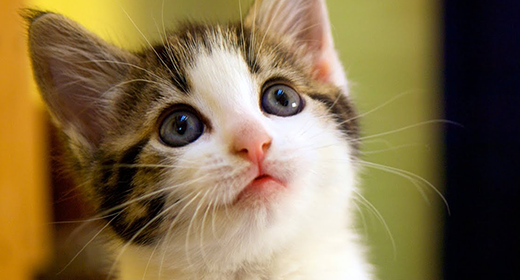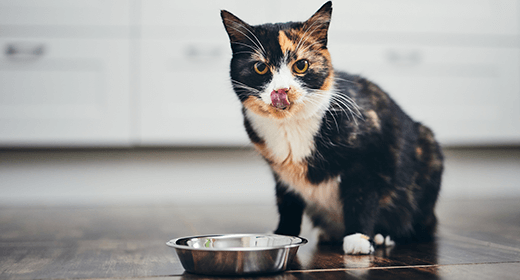

Hi, I'm Caitlin Lewis, Community Outreach Manager for the Humane Society of Greater Dayton, on behalf of IAMS. Wanting to adopt a cat or kitten, but not sure where to start or what to expect? Caitlin Lewis, Community Outreach Manager for the Humane Society of Greater Dayton, explains what you should do before you adopt a kitten or cat, including how to choose a cat personality that meshes with your family. Plus, you’ll learn about the adoption process and how to prep your home to make your new cat feel welcome. Hi, I'm Caitlin Lewis, Community Outreach Manager for the Humane Society of Greater Dayton, on behalf of IAMS. Wanting to adopt a cat or kitten, but not sure where to start or what to expect? Well, we're here to talk about everything you need to think about and do before, during, and after a cat adoption, in order to have a great experience for you and to provide a great home for your new pet. Research is a vital part of pet adoption. So we encourage prospective adopters to make several visits to their local animal organizations during the process.
Utilize their websites, so you can clearly understand the needs of your prospective pet, before making this important decision. Before heading to the shelter, you'll want to identify which cat breed would best fit your lifestyle. Fewer than 10% of the world's cats, both in and out of shelters, are purebred. The majority, common house cats, have charmed their way into becoming the number-one most popular pet in the United States. Before heading to the shelter, there are a couple of final considerations for you and your family. If yours is a full-time working household, it is recommended that you pass up kittens and adolescents, cats less than 18 months old, in favor of a more low-key adult, whose energy needs will be easier to meet. If you're a novice cat owner, think twice about excessive cats—excessively shy, aggressive, or demanding—for they may provide too great of a challenge for your first experience. Is coat color or pattern important? By all means, choose a cat who attracts you. But remember that the gorgeous calico hiding at the back of her cage may well go into prolonged hiding once she is released into your home. A cat that is social and relaxed at the shelter usually has the ease to meet the stresses that life throws her way. Consider the whole cat, not just one element. Your best bet is the friendly outgoing cat, who offers an outstretched paw through the cage bars, and who nuzzles and purrs when you hold him in your arms. This profile is a particularly good choice for families with young children. A cat in your life can add warmth, humor, and peace of mind. A cat can teach your child empathy for others, while keeping her secrets. If you can make the commitment, a cat is waiting to enhance your life in ways only a kindred spirit can. Loving pets of all shapes and sizes are waiting in animal shelters, hoping to find a permanent home. But there are many misconceptions about shelter pets. Shelter animals can make wonderful lifelong companions, if only given the chance. People often think shelters contain only the rejects, pets that have a health or behavior problem. This is not true. Shelters are filled with animals that have been surrendered by their owners because of divorce, owner illness, allergies, new babies, and inexperienced owners. Most shelter pets would like nothing more than a chance at a happy life and their own family to share it with. There are so many reasons for adopting from a shelter. Shelters have all types of pets, mixed breeds, purebreds, young and old. Regardless of the shape, size, or breed, most shelter pets are vet checked, healthy, and ready for their new homes, and will likely save you money, too. Adoption fees for shelter pets are typically less expensive than those you would find at a pet store or a breeder. Initial vet checks, vaccines, de-worming, and spay/neuter surgery are already included as part of the cost. You also get literature on caring for your new cat or kitten, plus support and guidance from shelter staff if you have questions. Pet adoption is an exciting but also time-consuming process. It's always best to call ahead to the animal shelter and find out what documents you need to bring with you. Typical items include: Picture identification with your current address If you're renting, bring your lease or a letter from your landlord. It must state that you are permitted to have pets and how many. Your landlord's contact information should also be displayed. If you own your home, you might be requested to provide proof of ownership, references. Have a list of references handy, including their phone numbers, and ask them for permission before using them as a reference. If you've had pets before, including a veterinary reference is a good idea. Cash, debit card, or credit card for paying the adoption fee. Smaller shelters or rescue organizations sometimes don't accept credit cards. Ask before if you're unsure. Everyone in your family. Many shelters require that every person in your household meet the pet you may be adopting. This is to ensure that everyone gets along and agrees to the adoption. Once you've introduced a new cat to the family, you want to make sure they feel at home as quickly as possible. Cats’ ideal refuge is a place where they can go and be with their things: a soft bed, food and water, a scratching post, and plenty of toys. Their area should be away from the rest of the house and out of the line of traffic. Finding just the right cat or kitten for you or your family is a rewarding experience. When that is coupled with bringing them home from a shelter, it is a double reward. By doing your homework and with a little patience, you'll have her home in no time. Let's recap. Do your research. Identify what type of cat would suit your family and lifestyle. Consider adopting from a shelter. And lastly, find out what you'll need to bring to the shelter. I'm Caitlin Lewis, on behalf of IAMS.


Cats are known for being a bit choosey about what they will and won’t do. And a little pickiness is fine when it comes to picking out toys and napping spots! But if your cat is or becomes extra-selective about what they’ll eat, it’s time to pay attention and perhaps talk to your vet. You and your vet know your cat best, so it’s always worth checking in if you think your cat isn’t eating enough and want their professional advice.
Start by paying close attention to what your cat is eating and how they behave. This information will help you, your household and your vet work together to make sure your cat is living and eating well.
Is your cat begging for table scraps or holding out on eating until you offer treats? Extras like these can be very disruptive to your cat’s appetite and diet. Think about them like snacks or desserts for you — tasty cravings that are easy to fill up on. A small portion may not seem like much, but it can make a big different for a cat-sized digestive system!
Try dialing back how much you treat your cat to tasty extras and see if their interest in the food bowl starts to return. Remember, it’s generally all right for cats to skip a few meals, but if they haven’t eaten for 24-36 hours it’s time to call the vet (even if they’ve continued drinking water).
Humans often crave variety in their meals, but for cats, routine is king. It’s not likely they’d avoid their regular food out of boredom with it, but if you’ve recently changed the kind of food, the number of feedings or the times you feed your cat, they may be avoiding eating as a response.
It's a good idea to change your cat’s diet gradually (unless your vet advises otherwise). Pickiness can often be resolved by helping your cat adjust and get comfortable with their updated diet!
If your cat starts eating less, you may want to look for factors that could be causing stress. Seemingly unrelated changes to their environment can shift your cat’s stress levels enough to impact their interest in food. Has another animal or person joined or left the household? Has your cat been adapting to new surroundings due to a move or renovation? As the stress of that change begins to subside, your cat will probably go back to a normal diet.
Talk to your vet about good ideas for reducing your cat’s stress levels and share any concerns you have about their diet then too. You’re both on the same team, so work together to help your cat feel better!